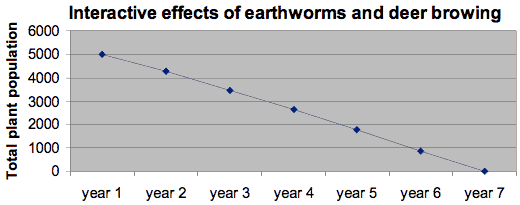Herbivory in a hardwood forest ecosystem occurs all the time but doesn't usually control what plants are or are not present. However, herbivory can have a severe impact when earthworms reduce the diversity and quantity of the remaining plant species. White-tailed deer particularly like to eat many of the native herbaceous plants that grow in these forests because they are both high in nutrient content and do not generally have bitter or toxic substances in them. When plants are numerous, deer can eat many of them and still not negatively impact the population over time. We can illustrate how this might happen in this hypothetical scenario:
Let us suppose there are 10,000 plants in a given area and those 10,000 produce 1,000 new plants every year (10% reproduction rate). If the deer in the area eat 1000 plants (10% browsing rate) in a year, the plant population remains constant (we are assuming no natural mortality in our hypothetical ecosystem).

When earthworms are added to the equation, their impact on plants is significant because they decrease the number of mature plants and may also decrease the number of new plants produced each year by eating the seeds and damaging the bulbs, rhizomes and corms of the mature plants.
After earthworms invade our hypothetical ecosystem, only 5000 plants remain. Overall, those 5000 plants produce 250 new plants a year (5% reproduction rate). The deer population stays the same and thus will continue to consume up to 1000 plants a year as long as they are available The graph below shows how this would lead to the elimination of the plant population in 7 years.

